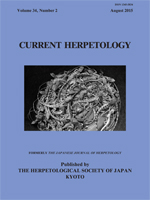The Hokkaido salamander, Hynobius retardatus (Caudata: Hynobiidae), is a common salamander species distributed throughout Hokkaido Island, Japan. Because of its regional morphological diversity and flexible phenotypic plasticity, its demographic history and the causes of its distribution patterns are of intrinsic interest to evolutionary biologists. To address these issues, a microsatellite marker is an ideal genetic marker for inferring gene flows and hybridizations between populations on a fine scale. We therefore utilized an Ion PGM™ sequencing system to screen the H. retardatus genome for microsatellite markers. As the result, we identified 12 polymorphic markers. We then tested the usefulness of these markers in H. retardatus by genotyping 20 individuals from each of two regional populations (the Erimo and Nopporo populations). The total number of alleles ranged from 3 to 8, and the expected heterozygosities per locus ranged from 0.049 to 0.803. We expect the developed markers to be useful for future studies of demography of this species.
How to translate text using browser tools
1 August 2015
Development and Characterization of 12 Microsatellite Markers for the Hokkaido Salamander (Hynobius retardatus)
Masatoshi Matsunami,
Takeshi Igawa,
Masafumi Nozawa,
Hirofumi Michimae,
Toru Miura,
Kinya Nishimura
ACCESS THE FULL ARTICLE

Current Herpetology
Vol. 34 • No. 2
August 2015
Vol. 34 • No. 2
August 2015
genetic diversity
microsatellite markers
population genetics
Salamander
Urodela




